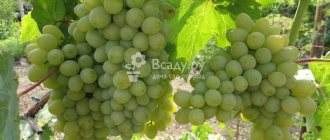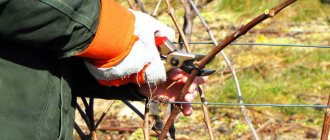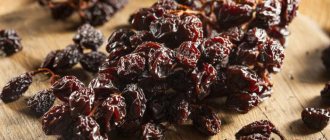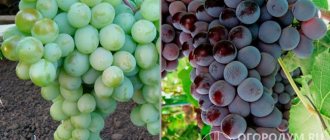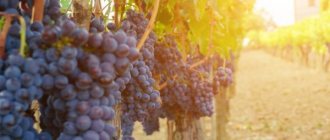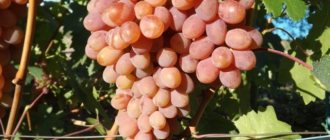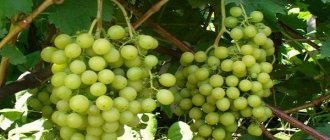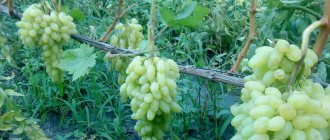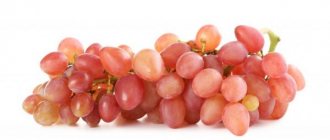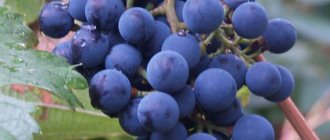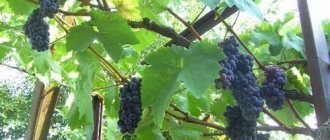The grapes prefer warm and well-lit garden areas, belong to southern crops and show the highest yield in the south of the country. However, this does not mean that it will not take root in the middle zone - a number of varieties adapt and bear fruit stably in regions with difficult climatic conditions (frost, winds, fogs).
These varieties are called uncovered - they do not require shelter for the winter, the shoots do not freeze, and ripen quickly the next year. We will look at which uncovered grape varieties are recognized as the best and what to look for when choosing.
Grape variety "Agat Donskoy"
An early-ripening, winter-hardy and mildew-resistant table variety. Harvesting maturity occurs in the second ten days of August. The bushes are vigorous, the shoots develop well. The variety is relatively resistant to mildew and gray rot. It can withstand frosts down to -26 °C. Standard formations with a bush load of 30-35 buds and a pruning length of 3-5 buds are recommended.
Characteristics of grapes
Each type of grape has its own qualities. Kuban grapes have many advantages, but they also have disadvantages. So, what are the characteristics of the variety?
- The grapes are delicious, tasting score 8.4/10. Sugar content 18-20%, acidity 5-6 g/liter.
- Productivity is high and stable.
- Wasps are indifferent to this variety, but for safety, experts still recommend putting each bunch in a special grape mesh bag.
- The Kuban grape variety can be stored on the branches for a long time, and even after harvesting it is in no hurry to spoil.
- Transportability is excellent!
- The variety cannot be called truly frost-resistant, but it can tolerate frosts down to -22 degrees without problems.
- Immunity to mildew is average, not afraid of gray rot.
- Pea berries are possible.
Alpha grape variety
The most common variety. It is characterized by increased winter hardiness and disease resistance. In the southern regions, the berries ripen 7-8 times every ten years.
In an uncovered crop, the yield fluctuates due to the death of buds from 0.5 to 4 kg per bush (with a fan formation). The berries are dark blue with a bluish tinge and are characterized by high acidity. Recommended mainly for landscaping in the southern and central zones. Option. Winter-hardy table, early-ripening, large-fruited form of selection from the Donetsk Experimental Station of Viticulture. Fruitfulness and productivity are high and stable. It bears fruit from replacement buds and lower buds. Harvest maturity occurs in late August - early September, 5-7 days before the ripening of White Shasla. Bushes of medium vigor with vine ripening of more than 80%.
For all regions of Donbass, standard formations with a height of 0.7-1.2 m with a load of 20-30 buds are recommended with short pruning of vines to 3-4 buds. The form can withstand frosts of -28 “C, and is affected by mildew and gray rot.
Conditionally covering varieties
This group includes crops that overwinter without negative consequences at a temperature minimum of -27-29°C. In the fall, when the harvest is harvested, the vines are removed and laid on the ground. Light materials are sometimes used as insulation, but these winter-hardy varieties do not require artificial heating. Snow cover is enough for them.
Crystal
A typical wine (technical) variety bred from universal Hungarian and Amur grapes. Favorable zones for cultivation are the North Caucasus and the Lower Volga region, but the variety is unpretentious and tolerates temperatures down to -29 degrees, and can be successfully planted in cold areas.
The berries ripen by mid-August (or later depending on the region). Productivity – from 150 c/ha. The clusters are medium, up to 200 g, the weight of each berry is 1.7-2.5 g. According to reviews from gardeners, Crystal requires protection if grown in the middle zone of the country. Overwinters under light cover.
Alyoshenkin No. 328
An early table variety, bred in the 50s at the Volgograd experimental station. The ripening period is up to 120 days; these grapes can be grown in regions with short summers. The crop is experiencing a strong drop in temperature; at -26 degrees, the berries remain on the vine. But this variety requires shelter for the winter due to the vulnerability of the underground part of the plant.
Suitable for cultivation in greenhouses. Productivity is 20 kg per bush and above. The berries are amber in color, weighing up to 5 g, round. Seeds are not found in all fruits and in small quantities.
Lydia
An American variety known as Isabella Pink. This is evidenced by the color of the berries: they are red with a purple tint. Large and juicy, the fruits are well preserved in severe frosts. Lydia has small, up to 100 g, clusters of small grapes that have an excellent taste.
The variety is planted for wine and for decorative purposes. The harvest ripens by mid-September; about 30 kg of berries are harvested from one bush. This must be done quickly, because... overripe grapes may break off in strong winds.
Lydia is a popular, folk variety. Its advantages include good transportability, long-term storage, and immunity to diseases such as oidium and phylloxera. The disadvantage is that the taste is not for everybody.
Little Dove
A complex hybrid bred in the 80s of the 20th century by breeders from Russia and Ukraine. A technical variety that has a pleasant appearance and good taste. The dove is unpretentious and productive, matures by 130 days, loves moisture, and is frost-resistant down to -26-27 degrees.
The variety is almost not affected by fungal diseases and is resistant to gray rot and mildew. The fruits of Golubka are black and round. The juice contains a lot of coloring substances. Suitable for making homemade wine.
Extra
A variety of American grapes, known to many as Elsinburg. The variety appeared at the beginning of the 20th century and is widely zoned, because. It easily tolerates cold, but in the northern regions it needs shelter. The growth vigor is high, the bushes are powerful, the berries have a unique, sour taste.
Productivity is good. Extra ripens by mid-September. There are disadvantages: the berries do not tolerate transportation very well.
Lady fingers
Known as Khusayne Bely, this variety was bred in Central Asia. The shape of the grapes is oblong, resembling the phalanges of fingers. The taste is sweet, with a pleasant sourness. Ripening time is about 140-150 days.
In central Russia, cultivating Husaine is not recommended, since it can only withstand temperatures down to -15-20 degrees. But it has a good yield, over 40 kg per bush. Read more about this grape variety here.
Moscow stable (Skuin 675)
Bred in Moscow by a Latvian agronomist, this variety is known under the name Skuin 675. An unpretentious early-medium variety, ripens in 130-150 days. Fruitfulness is high, on each shoot there are 3-5 bunches of grapes.
The berries are small and round and have a pineapple aroma. Suitable for wine and fresh consumption. Winter hardiness – up to -28-30 degrees.
Taiga
Amur grapes, which were originally grown in Primorye, and then successfully spread throughout Russia, amazing gardeners with their excellent characteristics: speed of ripening, frost resistance (up to -40 degrees), and resistance to disease.
It grows completely freely in the Moscow region and Siberia. The berries are dark blue, sweet and sour, medium in weight, used in winemaking. The variety is universal. One of the few non-selective varieties.
Grape variety "Delight"
Delight. Winter-hardy large-fruited variety of very early ripening. High-yielding, used fresh, suitable for making compotes and jams. The bushes are vigorous, with good ripening of the vine. The harvest ripens in the first half of August. It is characterized by high sugar accumulation - up to 24 g/100 ml with a harmonious combination of acidity and high transportability.
The variety is resistant to mildew and gray rot, and can withstand frosts down to -25 * C. Damaged by oidium. Standard formations with a load of 20-25 buds, short pruning for 3-5 buds and additional rationing of the bunches are recommended - leaving no more than 10-15 of them on the bush.
Early domestic varieties
The colder the region, the shorter the growing season of grapes should be so that the vine has time to gain strength and the fruits to ripen and be ready for consumption before the onset of rain and cold weather.
In areas with short summers, early varieties are chosen for planting. Their growing season lasts less than 4 months. Among them, it is worth paying attention to the varieties of Russian selection, bred specifically for the northern regions.
Cheremushka Siberian
Variety selected by Sharov. Early ripening grapes (growing season 110 days), the berries of which are small in size, especially in the first years, but pleasant in taste and aroma. It even looks like a bird cherry, hence the name.
The fruits can remain on the bush in a mature form for a long time. Siberian cherry tree tolerates cold temperatures below -25°C well, produces good yields and does not need shelter during the winter months.
Positive qualities include small seeds, high ripening of the vine, and resistance to parasites.
Bashkir early
A variety obtained by breeder L. Strelyaeva in the 1970s based on the Amursky variety. Bashkir grapes are highly resistant to frost, including the roots, and ripen early.
The growth power is average, the clusters are small, but the berries reach a weight of 10 g or more. The fruits are dark in color, sweet and sour. The yield of the variety is from 140 c/ha and above. It is not susceptible to some fungal diseases and parasites, but is not resistant to oidium.
Tukay
An unpretentious table variety, bred in Novocherkessk and intended for cultivation in any part of the country.
Ideal soils: loams, limestone, sandstone. Tukai ripens quickly; already at 90-100 days the grapes are ready for consumption. They are large (4 g on average), dense, and have a nutmeg taste. With good care, the berries remain on the vine for a long time and easily tolerate the first frosts.
White Muscat (Shatilova)
A hybrid variety of grapes that ripens by 115 days. The bushes are vigorous and produce excellent harvests. The weight of the bunches can reach 1 kg. The fruits are large, fleshy, with a nutmeg aroma.
Shatilov's grapes are resistant to oidium, mildew, and frosts down to -27°C. It winters well under a thick layer of snow, but does not always survive recurrent frosts.
Other very early frost-resistant varieties
There are other early grape varieties:
| Grape varieties | Growing season |
| Cardinal | 110 days |
| Sharov's riddle | 110 days |
| Relines pink seedlis | 105 days |
| Amethyst | 90 days |
Grape variety “Donetsk pearl”
Donetsk pearls. High-quality frost-resistant table form of selection from the Donetsk Experimental Station of Viticulture. The harvest ripens on August 25-30, with a growing season of 120-125 days. It is characterized by good sugar accumulation - 16-18 g/100 ml and high acidity (7-8 t/l). Bush of weak or medium vigor, with good ripening of the vine (80-90%).
Due to its high frost resistance (withstands frosts down to -27 degrees Celsius), it is recommended for uncovered crops on trunks 0.7-1.0 m high with a bush load of 30-35 buds and an average pruning length of 5-6 vines. The form is not resistant to pests and diseases.
Reviews of Kuban grapes
Not every region can grow Kuban grapes. So, in the northern regions it grows poorly, but in the middle regions it needs to be covered and well cared for. And yet, few people speak negatively about it, because the effort spent is paid off by a large, tasty harvest.
- Igor Dyachenko : “Kuban grapes have been growing at my dacha for a very long time. Productivity is always stable. Although I would like to note that regular treatments for parasites and diseases are needed. I didn’t process it a couple of times and lost almost the entire harvest!”
- Daria Kakovkina : “Tasty and very beautiful variety. The berries are incredibly sweet, sugary, the whole family loves them. The children are so delighted, they are always looking forward to the new harvest. It’s not easy to care for, but this is the case with any grapes – this is normal for the crop.”
- Svetlana Khodchenko : “I grow Kuban grapes for sale. As a product, this is an ideal variety - it tolerates transportation without problems, and if it crumples, it is not more than a couple of berries. The commercial quality is good, the grapes are noticeable and smell pleasant. Buyers are picking it up quickly."
Grape variety “Fragrant”
New very early variety. Ripens 127-144 days after the start of the growing season. Requires shelter for the winter. Productivity is 1.2-2 kg per bush. The berries are medium-sized, round, yellowish when ripe. The best formations are the double-shouldered Guyot and the fan without a standard. Recommended for cultivation as a wall crop.
Varieties by region
Frost-resistant varieties are zoned for different parts of the country: the Far East, the Urals, the Non-Black Earth Region, and Primorye. Some species have difficulty withstanding warm winters with frequent thaws. The fruiting of the variety is affected by the average temperature of the warmest month of the year, which is usually July. The harvest will be of good quality if the temperature is:
- not lower than 18 degrees for non-hybrid varieties;
- at least 12-14 for hybrids.
Best crops for different areas:
| Recommended areas (for cultivation) | Varieties |
| Central Russia | Alpha, Tukay, Isabella, Northern Saperavi, Lucille, Aleshenkin, Crystal |
| Northwest | Tukay, Skuin 675 (Moscow), Amethyst, Sharov's Riddle, Relines pink seedlis |
| Siberia and Far East | Amur Breakthrough, Sharov's Riddle, Aleshenkin, Skuin 675, Taiga, Siberian Cheryomushka, Lydia, Isabella |
| Ural region | Valiant, Lucille, Bashkir early, Muscat Bely, Aleshenkin |
| Altai | Cheremushka Siberian, Tukay, Extra |
Grape variety “Dawn of the North” (bred by Ya. I. Potapenko and E. I. Zakharova)
Bushes of medium vigor, high yield, with well-ripening shoots. Ripens much earlier than non-frost-resistant varieties. Quite resistant to mildew. Fruits in the second or third year after planting.
The leaves are small, three-, rarely five-lobed, with a net-wrinkled surface. The flower is functionally female. The best pollinators of the variety are European-Amur hybrids. The clusters are medium-sized, conical or cylindrical, dense or medium-density. The berries are medium-sized, round, black, with a strong waxy coating, and accumulate sugar well. The pulp is juicy, slightly crispy, the combination of sugar and acid is harmonious.
Grapes covered and uncovered
Grapes love warmth and above-zero temperatures, so they belong to the covering types of plants. Light frosts can destroy its annual shoots. Old vines and mature shoots can withstand adverse weather conditions, but severe stress can subsequently affect the harvest. Therefore, breeders have developed a special variety - an uncovered grape variety that is not afraid of unfavorable climatic conditions. Summer residents who have been growing this heat-loving plant for many years acquire frost-resistant varieties that adapt well to temperature changes in our country.
Covering varieties include the following varieties: “Kodryanka”, “Lora”, “Kesha”, “Moldova”, “Arcadia” and “Kishmish”.
For non-covering ones : “Jupiter”, “Venus”, “Isabella”, “Platovsky”, “Ontario”, “Lydia”, “Amethyst”, “Oasis”, “Alpha”, “Vatra”, “Andronova”.
Variety "Kodryanka"
Descriptions and photos of the fruits of this variety arouse active interest among summer residents and increase the demand for this species among beginning winegrowers. The Kodryanka berries, like the fruits of the parent varieties Marshallsky and Moldova, ripen in 110-118 days. The plant's wattles are large, strong, and can withstand decent harvest volumes; the weight of one bunch can be from 0.4 to 1.5 kilograms.
A significant advantage of this variety is its rich, sweet taste. The length of one berry is about 3 centimeters and the weight is 7 grams. The color of the fruit is blue-violet, very rich, the skin is almost invisible. The grapes tolerate transportation well, while maintaining their best qualities.
It is important to know! The main disadvantage of this variety is the crushing of the fruits; this feature can be overcome with the help of gibberellin, which has a positive effect on increasing the volume and weight of the berries, and will also help to significantly reduce the number of seeds in them.
Variety "Isabella"
Isabella berries are black, with a slight bluish tint, covered with a whitish coating on top. The skin is dense, hiding the tender and juicy pulp, which has a pleasant taste and smell of strawberries. It is recommended to plant seedlings of this variety in early spring or early winter. The variety is suitable for the Moscow region and produces a good harvest in this region. The berry reaches full maturity 180 days from the moment the first buds appear. "Isabella" has powerful and tall fences, on which there are a large number of medium-sized clusters. Grape growers note the high yield of this species, which can amount to more than 70 centners per hectare.
Grape variety "Beauty of the North" (Olga)
Beauty of the North (Olga). An early-ripening, large-fruited table variety with increased frost resistance. Very fruitful and high-yielding. The bush is vigorous, with good ripening of the vines. Harvesting maturity occurs in the first half of August. The duration of the growing season is 110-115 days. Susceptible to mildew and oidium. Relatively resistant to gray rot and cracking of berries. Winters well without covering the bushes in frosts down to -25 degrees Celsius. The load on the bush is 35 shoots, leaving no more than 20 bunches. Suitable for long-term storage. The bunch is large, branched, loose. The berries are large, white.
The variety is characterized by strong growth, so it should be placed in rows every 1.5-2 meters. Requires careful wrecking. No more than two bunches should be left on one shoot. The best shape is a four-armed fan. Recommended for cultivation in the central zone only as a wall crop.
How does a grape bush grow?
The growing season of grapes is also influenced by the soil temperature in the zone where the bulk of the roots occur, and even more so by the temperature ratio of the tops and roots. If one end of the vine is placed in a warmer place than the other by several degrees, then after 10 days the bulk of the biologically active substances will concentrate on it in the form of influxes. This process is called kilching and is explained by the fact that all living things strive for warmth and light. The movement of life potential is especially clear under the coordinated action of thermal and gravitational fields. For example, if the vine is located vertically, and its lower end is warmer, then after 15 days at a temperature of +180 a whole broom of roots directed downward will form there. Roots move towards a source of heat and gravity. If the upper end of the vine, under the same conditions, is warmer, then the warmest part will swell and the bud will begin to develop intensively. The growth of shoots goes towards a heat source from a source of gravity. Therefore, if the source of heat and gravity coincide, then the roots grow first and the growth of shoots is inhibited. Therefore, in our zone it is necessary to limit the heating of the soil, preventing it from overheating.
At the beginning of the growing season, the soil is usually cold and the temperature difference between roots and shoots reaches 20°. Plants are deficient in plastic substances, but have the strongest growth potential. If in the zone of the 55th parallel soil warming is delayed until June 15, then atrophic growth of shoots with long internodes up to 35 cm and inhibition in the development of inflorescences appears.
Then a stabilization regime sets in, when the soil temperature is above +15° and approaches the air temperature, which in the zone of the 55th parallel is equal to the physiological optimum and averages +20 +24°. At this time, plastic substances easily enter from storage areas into the growing parts of the plant and into the ovaries, to which the result of productive photosynthesis is added. The growth potential decreases, the internode size decreases to 10-15 cm, and the fruiting potential (formation of berries and fruit buds) increases significantly. This regime is more pronounced the smaller the temperature difference between the shoots and roots. The external manifestation of this regime is a reduction in the length of internodes and a rapid increase in the size of the berries. At the moment when the soil temperature equals the temperature of the roots, in the 1st ten days of August the growth potential drops completely, although the shoots continue to grow. At this moment, the size of the internodes decreases to 5 cm, and the tips of the shoots straighten and this is a signal for the end of this regime. This is the signal to start minting.
When nighttime air temperatures drop below soil temperature (August 20), accumulation occurs in the active root zone. The greater the temperature difference between the still warm soil and the temperature of the shoots, the better the active roots grow and the more plastic substances flow from the shoots to the roots. There is even a decrease in sugar in the berries, if they are already ripe, and in the speed of ripening of the vines.
It can be recommended to reduce the period of the first and third regimes as much as possible and increase the period of the second – stabilization – as much as possible. When selecting varieties, take into account not only the sum of active air temperatures, but also information about soil temperatures, their differentiation and the duration of sunshine in a particular place. That is why, near the southern wall of the house, any early varieties that fall within the ripening period are always especially productive and give a high-quality harvest .
Grape variety “Lydia”
Lydia is a high-yielding (Isabella type) late-ripening variety. The berries are consumed fresh, and sweet wines and juices are prepared from them. A bush grown near walls often produces a yield of 40-50 kg. The variety is moisture-loving, so it is better to plant it in places where groundwater comes out. It is not affected by mildew and oidium. It bears fruit from the third year of planting. In Ukraine, this variety can be recommended for semi-covering crops (sprinkling soil on the trunk and the base of the sleeves). Lydia can also be grown in pots.
The leaves are large, three-lobed, light green. The flower is bisexual. It blooms somewhat earlier than European varieties. The clusters are small, conical, loose or of medium density. The berries are large, dark pink. In shaded places they do not acquire their characteristic beautiful colors. The peel comes off in the form of a pouch. The pulp is slimy, with a very pleasant strawberry aroma.
Varietal diversity
Some frost-resistant grape varieties are universal: they are tasty fresh and suitable for the industrial and amateur production of a variety of drinks. Many of them are divided into:
- table - they are consumed fresh, unprocessed. They stand out for their pleasant taste, aroma and appearance;
- technical - for the production of juices, including for children, wines, and other drinks with and without alcohol.
Like any crop, grape varieties are early, mid-ripening and late-ripening.
Table varieties
Their taste and consumer qualities are excellent, so they are consumed mostly in unprocessed form.
Early ripening Muromets is one of the most delicious domestic table varieties. Pink bunches weigh up to a kilogram. Taste with a slight hint of nutmeg, sweet. The bush bears up to 7 kg of fruit. Tolerates frosts down to -26 °C “excellently.”
Pink pearls are high-yielding and versatile. Up to 8 kg of sweet brushes are collected from the bush. There are few seeds in the fruit. Overwinters on a trellis at -30 °C. It is not affected by fungal infections and has excellent resistance to pests. The percentage of ripened ones is at least 95%. Sugar content - 20-25%. The only weak point of Pink Pearls is that they are damaged during transportation.
The peculiarity of the Kishmish grape is its sweet taste and the absence of seeds. The weight of the bunches sometimes exceeds a kilogram. The berries are small but juicy. Keeping quality is long compared to other grape varieties. It is considered a table species, although sweet wine can be made from the fruits. In addition, the berries are dried. Kishmish’s homeland is hot Central Asian and Middle Eastern countries, but breeders have developed frost-resistant varieties. The most popular of them are:
Technical varieties
“Isabella” grape varieties make up a large share in the list of non-covering technical varieties - these are American grape varieties characterized by exceptional winter hardiness (so named after one of the prominent representatives - the Isabella variety). Having taken root in the middle zone, they bear fruit in clusters that are smaller than European varieties. Not all consumers like the special “strawberry” flavor of berries, but many varieties—Buffalo, Pineapple Early, Seneca, Ontario—have virtually none of it.
Promising winter-hardy technical grape varieties also include:
Wines from Muscat are especially aromatic, with a bright and powerful taste. The clusters are on average 10 cm in length. The fruits are round, approximately 1.5 cm in diameter. The pulp is juicy, the aroma is nutmeg. The variety was originally cultivated in warm, sunny France, Spain, Italy, and Portugal, but frost-resistant technical varieties were bred:
Uncovered, frost-resistant grape varieties are a real gift for gardeners, winemakers and consumers in countries with frosty winters. Their correct choice is the key to obtaining a vitamin harvest, delicious juices and sweet wine. Due to the fact that frosty winters are the norm in most of the country, they are in demand in both industrial and amateur viticulture.
Grape variety “Lyana”
Brought out by breeders of the Chisinau Agricultural Institute and the Moldavian Research Institute of Vierul and VieruV by crossing the varieties Chaush white and Pierril (Save Villar 20-366) with subsequent selection against an infectious background. A table variety with a medium ripening period, that is, it ripens almost simultaneously with the white Chasselas variety. The duration of the period from bud break to grape ripeness is 135 days at a sum of active temperatures of +2450 °C. Productivity is within 120-150 c/ha. The average weight of a bunch is 215 grams.
The variety is quite frost-resistant, increased resistance to mildew (virtually does not require spraying), anthracnose, and oidium (2 points). Resistance to phylloxera and gray rot 3 points. The bushes develop well on the trees of Berlandieri x Riparia Kobera 5BB, C04, Riparia x Rupestris 101-14. Pruning shoots into 6-9 buds, a load of 40-50 buds per bush. As a variety with group resistance, fairly high indicators of taste, elegant bunches and berries, it should be tested in all natural regions of Donbass, and in the southern regions - with a high-standard culture.
Particularly resistant non-covering hybrids
There are grape hybrids whose bushes are able to withstand especially low temperatures and at the same time exhibit accelerated growth rates. The fruits ripen quickly and require less heat. This makes it possible to grow such crops in high-risk areas with harsh winters and unpredictable summer weather.
Recommended winter-hardy varieties of American selection:
- Reline Pink Seedlis is the most frost-resistant American hybrid (down to -27°C). The fruits are pink, seedless, with a labrusca aroma, suitable for drying, making juices, wine, and eaten fresh. Ripening dates are very early (105 days). Permissible load - 50 eyes per bush.
- Taiga emerald is a hybrid from the Primorsky Territory, obtained from the American variety Minnesota. The berries are consumed fresh, their sugar content reaches 19.5%. The shoots of this high-yielding variety manage to ripen during the short autumn. It has high frost resistance and is tolerant to mildew.
- Valiant is a super winter-hardy species, the vine can withstand temperatures down to -47°C. Early ripening. The berries are black and blue with large seeds and a fruity aroma. Some samples had a strawberry flavor. The clusters are moderately dense and can remain on the bushes for a long time.
- Triumph is an American table variety with vigorous shoots, long conical clusters and large oval fruits. Ripens in the second half of August. Capable of increasing varietal characteristics with age.
Triumph
Non-covering varieties of American origin also include: Kay Gray, Mure Earley, Venus. When bred, Euro-American hybrids received resistance to phylloxera, which makes them stand out when choosing a variety for planting. Frost resistance of such varieties is slightly lower - from -30 to -34 ° C, but tolerance has been achieved to almost all diseases that plague vineyards.
Kay Gray grapes
Some European frost-resistant species:
- Lando Noir;
- Louise Swenson;
- Somerset Seadleys;
- Prairie Style.
The grape varieties bred in Russia from local relics through selection and selection are not inferior in quality, and in some respects even superior to their foreign relatives. The small-fruited Amur liana has been transformed in the hands of breeders into many varieties that at the same time have frost resistance, excellent presentation and high taste.
Amur grapes grown, for example, in the Smolensk region, show a sugar content of 21.4%. Its vine tolerates frosts below -40°C during snowless periods in open vineyard conditions.
Recommended varieties for the northern regions and the Far East:
- Vaskovsky hybrids (No. 5 and No. 6);
- Shatilov hybrids (from 2 to 15);
- Latvian variety Gulya;
- Khasansky Bousa and Khasansky sweet;
- Cheremushka Siberian;
- Bashkir early.
Khasansky Bousa
Many other varieties for each region are regionalized or obtained through selection by amateur winegrowers and specialized institutes. But the high characteristics of a hybrid do not yet guarantee successful cultivation and a bountiful harvest. Along with its unique qualities, northern grapes are distinguished by the principles of care, pruning and other features.
Grape variety “Metallic”
Metal. Frost-resistant, fairly productive variety, obtained by I.V. Michurin. Fruiting usually begins in the third year after planting. Medium sized bushes. It is undemanding to soil and topography, but on light soils (sandy loam and sandy) in the southern location it ripens somewhat earlier.
The leaves are medium-sized, five-lobed, slightly wavy, rounded. The flower is bisexual. The clusters are small, cylindrical or cylindroconical, dense. The berries are medium-sized or small, round, red with a bronze tint. The pulp is slimy. The disadvantage of this variety is its rough, inedible skin.
From the history of grapes
According to historians and archaeologists, viticulture dates back at least eight thousand years. The ancient peoples of Asia and Africa feasted on sunny berries, then it ended up in Europe and conquered both Ancient Greece and the Roman Empire.
Vintage image
The grapes still had a long way to go to the Black Sea region and the North Caucasus. Only at the beginning of the 17th century the first vineyard appeared in the Astrakhan region, and then, at the behest of Tsar Alexei Mikhailovich, in the Moscow region, where it was grown using the covering method.
At the beginning of the 18th century, Tsar Peter initiated the first steps of viticulture on the Don - near the villages of Razdorskaya and Tsimlyanskaya.
Cossack selling Tsimlyansk wine, 1875–1876
In the last quarter of the same century, vineyards appeared in the Derbent region, Prikumsk and Tver regions, and in the second half of the 19th century - in Kuban.
Grape variety “Muromets”
A comprehensively stable, very early-ripening, large-fruited variety bred by the Central Genetic Laboratory named after. I.V. Michurina. Fruitfulness is high. The harvest ripens in the first half of August.
The bushes are vigorous. The shoots ripen well. The variety can withstand frosts down to -26 C, is resistant to mildew and gray rot, and is susceptible to oidium.
Agricultural technology of uncovered varieties
Despite the fact that varieties of this species are resistant to cold, it is necessary to accustom young seedlings to frost not immediately, but gradually. For example, for the first three years, a newly planted vine must be covered, just like weaker varieties. And with each wintering, wrap them up later and reveal them earlier. It will also be necessary to assess the damage caused to plants after each opening.
In this way, the grapes will be hardened and in the future they will endure the cold season without any problems. These recommendations apply, of course, to the climate zone where the warm time of the year is no more than four months. In warm climates there is no need for shelter during the cold season. This is why all professional gardeners say that the same variety behaves differently in different zones.
According to the characteristics, grapes of uncovered varieties can tolerate the lowest possible temperature down to -29 degrees. In some varieties this figure drops to -32 degrees. Although, it is not recommended to go to extremes, but to select individuals based on the specific temperature and climatic data of your region.
For example, in regions where winter is unstable and there are thaws, it is recommended to remove the vines from the trellises and lay them on the ground for wintering. This will prevent the kidneys from waking up ahead of time, and then they will not be injured by frost.
Summer residents, in turn, have chosen “Isabella” varieties for themselves. Despite the high sugar content in the berries, their frost resistance is more than suitable for the Moscow region, for example, or the cold parts of Ukraine. They are also unpretentious in care and do not require much effort on the part of the owner of the site. Only sometimes in the summer - watering, and in the spring - fertilizing with compost or nitrate.
Since these grapes are resistant to various diseases or bacteria, they do not need additional protection, only in case of a specific danger. In addition, they have a high ability to regenerate, which is also a huge plus. In general, it is advisable to plant uncovered varieties on the south side of the plots and provide them with sufficient sun in the summer.
Grape variety “Russian Concord” (bred by I.V. Michurin)
Consumed fresh, but also good for making juice. The bushes are distinguished by high frost resistance, strong growth, good ripening of shoots, and high yield (with normal pollination). It begins to bear fruit from the third year after planting.
The leaves are large, three-lobed (sometimes almost whole), rounded in outline, with a slightly wavy surface and a less colored underside of the blade. The flower is functionally female. The best pollinators are Black Sweet and Metallic. The clusters are medium-sized, cylindrical. The density of the bunch depends on pollination conditions. The berries are large, red, round. The skin is medium thick, easily torn. The pulp is juicy, fleshy-slimy, with a slight strawberry flavor.
Caring for Kuban grapes
Caring for the Kuban variety usually does not cause serious problems, but you should not relax. Like any other grape, it can suddenly become ill or fall off for unknown reasons - you must always be on guard.
- A good support is provided for the vine so that the grapes curl up and do not spread along the ground.
- Watering is not carried out often, but abundantly. You need to pour at least 3 buckets of warm, settled water under the bush. But, in general, the amount of irrigation and water depends on the weather. The more rain, the less frequently the bush is watered.
- From about 3 years after planting, you can begin to feed the grapes, because before that the bush has enough nutrients added to the ground during planting.
- Since there is a lot of foliage on this grape, some leaves are often torn off so that the bush can be evenly warmed and illuminated. But, it is not recommended to pick leaves from the bunches, because the berries in the sun can simply fry or raisin.
- Due to its low frost resistance, the variety is covered for the winter in all regions, except perhaps the southern one, if severe frosts are not predicted.
- After winter, when the grapes are opened, you need to clean them of last year's leaves and old bark on the vine (superficial cleaning so as not to damage the vine). This is done in order to get rid of pest larvae and disease spores that could overwinter in them.
Grape variety “Salem”
It is characterized by increased winter hardiness and resistance to fungal diseases. The berries are small, coral-red in color. Ripens 10-15 days later than Solovyova 58. Salem can be used to create any formations when landscaping buildings, arranging trellises, gazebos. It takes root poorly with shortened cuttings, best of all with layering. Recommended for amateur breeding in the central and southern zones of Ukraine.
Important advantages of varieties
Determining which grape variety is better is not an easy task; novice breeders in Russia pay attention to the characteristics of each species and take into account significant qualities, which include the following:
- resistance to temperature changes and adverse climatic conditions;
- the ability to produce a rich harvest;
- resistance to various types of diseases;
- size of bunches and fruits;
- grouping of berries;
- active and rapid growth of grape vines;
- early maturation;
- resistance to insect damage.
Important factors for determining the best grape variety are also the rich taste and sleepiness of the berry pulp, sweetness, their size and color.
Do not forget that the harvested grapes must sometimes be transported over very long distances. Therefore, the ideal grape variety should retain its appearance and taste for a long period of time. Remain juicy and tasty when it hits the store shelves and the buyer’s table.
Grape variety “Northern Saperavi”
A comprehensively stable technical black-berry variety bred by VNIIViV named after. Ya.I.Potapenko.Differentsed by very high fruitfulness of shoots, including those from replacement and corner buds. Maintains stable high yield. Withstands frosts down to -28 °C. Has increased resistance to mildew. It is characterized by good sugar accumulation (19-20 g/100 ml) and high acidity of the juice (9-11 g/l). Ripens in the second half of September.
Can be used to make juice and dessert wine. Bushes of medium vigor with good ripening of shoots.
Grape pruning
The law for grapes is simple:
Cut off the excess from the vine -
The grape will become heavier.
Jacob Kats (1577—1660)
To normalize the harvest in the fall, from October 15 until frost, excess shoots are pruned. In spring, pruning is not done due to the strong weeping of the vines.
1. Start pruning
at the base of the bush after removing stumps.
2. Removing excess and old sleeves
. A young bush should have up to 3 shoots (sleeves) extending from the root below ground level: 2 main and 1 reserve. On a fruit-bearing bush 4-6 years old, the number of sleeves can be increased to 4 pieces, located 2 pieces on the left and right along the trellis.
On mature powerful bushes over 7 years old there can be up to 6 sleeves: 2 on the left, 2 in the center of the bush, 2 on the right along the trellis. Excess sleeves, the most aged ones, are removed in the same way as stumps.
3. Trimming excess arrows and buds
. First of all, it should be noted that the technology of northern pruning is very different from southern pruning. Due to the abundant nutrition of buds on fruit-bearing shoots, they develop better than on replacement knots, so in the north there is no need for replacement knots. And due to the faster lengthening of the sleeves, every year a new sleeve is formed from the shoots at the base of the bush - a replacement sleeve from the most powerful shoot with three buds extending from the root. From the remaining sleeves, first of all, immature, diseased, weak, thin shoots are removed by cutting them off with pruning shears, leaving a stump of approximately 0.5-1 cm to avoid deep wounds.
Make the cut perpendicular to the shoot. From the young vines (arrows) remaining on the sleeve, one of the most powerful, most mature shoots with the largest buds is selected, the rest are removed. The remaining young shoot (arrow) is shortened to the required length, for example, for a high formation on a T-shaped trellis, the total length of the sleeve and arrow can be up to 2 m. In other options, the shoots (arrows) are left with 4 fruit buds: so, if fruit buds begin after the 4th bud, then 8 buds are left, and if fruit buds begin after the 3rd bud, then 7 buds are left, and so on. It all depends on the characteristics of the variety. The excess part of the arrow is cut off in the middle of the internode perpendicular to the shoot. Stepchildren are pruned in the middle of the internode after the first bud, which will be a reserve in case of May frosts. In the case when the stepsons are completely removed, they are cut off at a distance of 1 cm from the shoot to avoid damage to the main fruit bud at the base of the stepson. One fruit arrow is usually left on each sleeve without a replacement knot. If the sleeve is very powerful, and there are two of the most powerful arrows and it is not clear which one to leave, then leave both, but leave 1 less bud on each. But there is a rule: the remaining arrows should not come out of one bud on the sleeve and should be located at different levels from the root. On an old five-year-old sleeve, you can leave 3 fruit shoots at different levels from the root, but you need to count the fruit buds. There should not be more than 8 on each sleeve.
Grape variety “Northern” (bred by Ya. I. Potapenko and E. I. Zakharova)
The variety is winter-hardy, productive, and ripens earlier than non-frost-resistant varieties. The bushes are vigorous, the shoots ripen early. The ability to easily accumulate sugar makes the variety suitable for producing sweet wines. Fruits in the second or third year after planting.
The leaves are medium-sized, entire, less often three-lobed, slightly elongated. The flower is functionally female. The best pollinators are European-Amur hybrids. The clusters are small or medium-sized, conical or winged, loose. The berries are small or medium-sized, dark blue, round. The pulp is juicy, with a faint aroma.
The best grape varieties with early ripening berries
One of the most popular and well-known varieties among those that have a short ripening period and high yield is “Pearl Sabo”. It only takes 80 days for mature fruits of this species to appear. The taste of the berries has a pleasant nutmeg flavor. The only slight drawback of Sabo Pearls is the small berries.
Competing varieties often bear quite large fruits. Types of grapes that ripen early include:
- “Ekaro-35” - ripe fruits can be obtained already on the 88th day;
- “Galahard” - berries ripen on the 89th day;
- “Serafimovsky” - fruit ripening will not exceed 89 days.
Watch the video! Review of super(ultra)early grape varieties
Grape variety “Solovieva 58”
The berries ripen in late September - early October. The yield per bush is 3-4 kg and above. The berries are yellowish-green, covered with a brown net, and have a pleasant nutmeg-strawberry flavor. The variety produces 2-3 fruitful shoots from one eye, and up to four clusters on one shoot. If the debris is green, one shoot should be left per node. In some cold years, part of the uppermost inflorescences should be cut off. The variety bears fruit well in various formations. Recommended for cultivation in open ground in the central and southern zones of Ukraine. Taiga emerald. Similar to the Alpha variety. In contrast, it has light green berries. Ripe berries have a pleasant taste. The variety is recommended for the same purposes and areas as Alfa.
The most popular varieties
There are more than twenty uncovered grape varieties, and each of them has its own advantages and disadvantages. However, all summer residents and winegrowers choose for themselves, as expected, the variety that will satisfy both taste requirements and will be unpretentious in care. In addition, over many years, gardeners working in the middle climate zone have determined the most optimal options for themselves.
If not the most popular, then at least one of these varieties can be called a guest from America - Isabella grapes. This variety was first brought to the territory of the USSR back in the mid-50s of the 20th century. And since then it has firmly taken root in almost every private house, on every summer cottage. Moreover, the berries are used not only for food, but also for canning and making wine - bottles with the same label adorn the shelves in any store.
The most comfortable climate for this variety is temperate, almost subtropical. That is why Isabella is grown almost everywhere in the post-Soviet space, except for the most northern regions. As for the external characteristics, one can note the roundness of the berry; its size reaches no more than 18 millimeters and 3 grams. The dark blue, sometimes transparent, skin is covered with a waxy coating. The pulp is slimy, has a sweet and sour taste and a specific, bright odor.
The bunch itself is usually not very large - up to 150 grams, tightly entwined with berries. As for the vine, it has a large number of buds, and on each fruit shoot there are up to three clusters. Isabella ripens late, but there are no problems with transporting the crop. It is worth noting the high resistance of the variety to severe frosts and various diseases.
Lydia (Isabella pink)
Another popular variety in mid-latitudes is Lydia. Like the two previous specimens, it was also bred in America and is a hybrid of the Labrusca species. Lydia, like many other grape varieties, ripens by September. It is then that the green, round, slightly elongated berries turn pink, almost transparent. The skin is dense, with a waxy coating. The pulp of the berries is slimy, aromatic with a pronounced taste. Lydia's brushes are large and not dense. It is resistant to diseases and bacteria and is not afraid of frost.
By the way, you can use the Lydia vine not only as a fruit crop, but also as a decorative decoration for your estate or gazebo.
Amethyst
This grape can rightfully be called the most frost-resistant, since the maximum temperature it can withstand painlessly is minus 35 degrees. There are also advantages to low susceptibility to disease. At the same time, the berries of Amethyst are distinguished by good ripening, and the vine itself is characterized by rapid growth and a powerful skeleton.
The fruits ripen quite early - by the end of August you can already enjoy juicy berries of a dark blue, almost black color. The variety is also quite sweet in comparison with its other relatives. Amethyst clusters grow large - up to 700 grams.
Grape variety “Violet Aviganovsky”
A very early ripening variety. Resistant to fungal diseases. In the southern zone it overwinters without shelter and bears fruit annually. It does not take root well from cuttings; it is better to propagate by layering.
The bush is medium-sized, with a yield of 3-5 kg. The average weight of a bunch is 70-75 g, the maximum is 175. The berries are medium-sized, cherry in color. They ripen in 127-144 days from the beginning of the growing season.
Growing grapes in wall culture is becoming widespread. Many amateur gardeners successfully grow its local varieties.
For landscaping purposes, the most suitable varieties are Amur and wild grapes, which grow well in all regions of the republic.
Grapes in central Russia
The first successes in promoting grapes to the northern regions were achieved through the work of Ivan Vladimirovich Michurin, who crossed American, Amur, North Chinese and Mongolian grape varieties, trying to obtain a variety more resistant to frost. As a result, he bred the Russian Concord, Bui Tur, Arktik, and Metallichesky.
Now there are many varieties that can be grown in the middle zone. Grape breeders and practical winegrowers recommend planting grapes with a short ripening period in this region, where the summer is quite short.
Only in the register of the State Commission of the Russian Federation for Testing and Protection of Breeding Achievements (FSBI “State Varietation Commission”) there are several dozen such grape varieties recommended for cultivation in all regions.
Grape varieties with a short ripening period, approved for cultivation in all regions - table
| Variety | Direction of use | Ripening period | ||||
| universal | dining room | technical | very early | early | mid-early | |
| Alexander | X | X | ||||
| Alyoshenkin's gift | X | X | ||||
| Alievsky | X | X | ||||
| Amur breakthrough | X | X | ||||
| Annushka | X | X | ||||
| Agate Donskoy | X | X | ||||
| Anthracite | X | X | ||||
| Anyuta | X | X | ||||
| The scent of summer | X | X | ||||
| Bashkir | X | X | ||||
| White early | X | X | ||||
| Bogotyanovsky | X | X | ||||
| Helios | X | X | ||||
| Gourmet Krainova | X | X | ||||
| Long awaited | X | X | ||||
| Ermak | X | X | ||||
| Zelenolugsky ruby | X | X | ||||
| Karagay | X | X | ||||
| Katyr | X | X | ||||
| Cocktail | X | X | ||||
| Kubattik | X | X | ||||
| Libya K | X | X | ||||
| Lunar | X | X | ||||
| Lyubava | X | X | ||||
| Lucy red | X | X | ||||
| Madeleine pineapple | X | X | ||||
| Manych | X | X | ||||
| Squeen's Dream | X | X | ||||
| Moscow white | X | X | ||||
| Moscow dacha | X | X | ||||
| Moscow sustainable | X | X | ||||
| Muscat Moscow | X | X | ||||
| Tenderness | X | X | ||||
| Lowland | X | X | ||||
| In memory of Strelyaeva | X | X | ||||
| In memory of the teacher | X | X | ||||
| In memory of Dombkowska | X | X | ||||
| Squin's firstborn | X | X | ||||
| Gift from TSHA | X | X | ||||
| Transfiguration | X | X | ||||
| Early TSHA | X | X | ||||
| Rochefort K | X | X | ||||
| Ryabinsky | X | X | ||||
| Skungub 2 | X | X | ||||
| Skungub 6 | X | X | ||||
| Strepenny | X | X | ||||
| Chrysolite | X | |||||
| Anniversary Novocherkasskaya | X | X | ||||
| Skuin's Anniversary | X | X | ||||
| Anniversary | X | X | ||||
Of course, there is no point in describing them all. Objective and independent information about them is provided in the register of the Federal State Budgetary Institution “State Sort Commission”.
Grapes in central Russia - video
Winegrowers, of course, grow not only those varieties that are included in the register of the State Commission for Breeding Achievements, but also those that are in the process of testing. Unlike varieties, these varieties of grapes are called forms. When choosing such plants for growing, accumulated practical experience plays an important role.
Based on the experience of practicing winegrowers, we will consider grape varieties that feel best when grown in open ground in the middle zone - Ivanovo, Ryazan, Kostroma, Bryansk, Tula, Tver, Kaluga, Vladimir, Lipetsk, Smolensk, Pskov, Yaroslavl, Nizhny Novgorod regions and Moscow region.
Regions of central Russia
When starting to grow grapes, beginners in this field should take into account that advice and recommendations are general in nature. A lot, for example, when choosing a variety depends on the specific place where the vine will be grown. Even within the Moscow region, climatic conditions and soil composition are very different in its southern and northern parts.
The difference is really big.
Where I live (Naro-Fominsk), the difference in temperature with the northern regions of the region is huge! If our snow can melt at the end of March, for example, then in the northern part it can lie for another whole month. The southern regions gain almost a month for farming!!! And this is not little. The composition of the soil is also different. Svetlana
https://vinograd7.ru/forum/viewtopic.php?f=26&t=17
Grape variety “Early Violet” (bred by Ya. I. Potapenko and E. I. Zakharova)
The variety is winter-hardy, early, productive, and adapted to the conditions of the southeast of the country. Capable of accumulating a lot of sugar. The bushes are vigorous, with well-ripening shoots.
A valuable table variety, also suitable for making juice and semi-sweet wine. The leaves are medium in size, often three-lobed, moderately dissected on the underside, with bristly pubescence. The flower is bisexual. The clusters are medium sized, branched. The berries are medium-sized, slightly oval. The color is purple. The pulp is juicy, with a pleasant nutmeg aroma.
Top best
When choosing a variety, pay attention to several criteria: taste, presentation of the berries, demands on growing conditions, ripening period. Let's consider the top best grape varieties for central Russia.
Lunar
A medium-early ripening table variety. The plant is medium-sized, with large dark green leaves. The clusters are large, cylindrical-conical, the average weight of one is 500 g. The berries are round-oval, one-dimensional, weighing 6 g. The skin is durable, the color is white-pink, there is a slight waxy coating. The flesh is crispy. sweet, with a pleasant nutmeg aroma. Tasting score - 8 points. Each berry contains 2-3 seeds.
The grapes can withstand frosts down to -22°C and are covered for the winter. Increased resistance to powdery mildew, anthracnose, rot, and septoria. Lunar is rarely damaged by insect pests.
Venus
Venus grapes are raisins. It does not require special attention and is suitable for summer residents who are growing crops for the first time. Venus does not require shelter for the winter and can withstand frost without problems. Ripening time is 115–125 days, the plant is tall. The clusters are of medium density, the weight of one is from 200 to 600 g. The berries are blue-black, small, weighing about 2 g each. The skin is thin and easily separated from the pulp.
Interesting! Many gardeners mistakenly believe that Venus and Venus are the same variety. This is not so: Venus sultanas have taller bushes, and in autumn the leaves are painted a brighter orange color. They are considered similar because of the same berries and taste. Only an experienced winegrower will distinguish Venus from Venus by appearance.
The taste of Venus berries is pleasant, harmoniously nutmeg, with a pronounced grape aroma. Kishmish does not deteriorate during long-distance transportation.
Chrysolite
The Chrysolite grape feels good in all regions of Russia: in the Moscow region, the Volga region, the Nizhny Novgorod region, and the Urals. Table variety, medium-early ripening period. The leaves are green, with slight pubescence, the shoots are flexible and powerful. The clusters are large, conical, weighing about 600 g. The berries are round-ovoid, green-yellow in color. The taste is sweet, the aroma is nutmeg, the juice is colorless. Tasting score: 8.6 points.
For better yield, Chrysolite is covered for the winter. Jams, jellies, marshmallows, and marmalade are prepared from ripe berries. Grapes are not used for transportation - on the road they quickly lose their taste and commercial qualities.
Aleshenkin's gift
Aleshenkin's gift
One of the most popular and productive varieties. Super early, with proper care the berries are harvested within 110 days. The bushes are tall, with developed vines, the leaves are green, smooth and without pubescence. The clusters are loose, cone-shaped, average weight is 0.5–1 kg, some specimens reach 2 kg. The berries are round-oval, weighing 4-5 g, the skin is translucent and durable. The color is amber, with a green tint, the juice is colorless. The taste is rich and very sweet, tasting score - 7 points.
Aleshenkin is suitable for fresh consumption and the preparation of juices, compotes, and jams. After processing, the berries do not lose their sweet and sugary taste. Among the disadvantages of the variety, average immunity to disease is noted, therefore, to obtain a good harvest, summer residents treat the plant with a solution of Bordeaux mixture.
Victoria
The Victoria table variety is valued for its attractive commercial qualities and is grown for personal consumption and sale. From the moment the buds open to the ripeness of the berries, 110–120 days pass. The frost resistance of the plant is down to -26°C; it requires shelter for the winter.
The clusters are loose, weighing from 500 to 700 g. The berries are oval, red-raspberry, very beautiful. The weight of one is about 5 g, the skin is dense. The pulp is sweet and aromatic, with a pleasant aftertaste. Victoria bears fruit 2-3 years after planting. Resistance to mildew is high, resistance to septoria and rot is average.
Crystal
Technical grade Crystal super early. The bushes are medium-sized, the leaves are strongly dissected, without pubescence. The bunch is medium dense, weighing about 170 g. The berries are oval-round, yellow-green in color. The taste is sweet, and the berries are used to make wine and champagne.
Summer residents note the variety's immunity to fungal diseases and frost resistance: the grapes can withstand temperatures as low as -35°C. Crystal does not cause any difficulties in planting and caring and quickly adapts to the climatic conditions of the region. It begins to bear fruit in the second year; after ripening, the clusters do not fall off.
Bacchus
The technical unpretentious Bacchus grape is resistant to spring frosts and bears fruit regardless of the place of cultivation. The color of the berries is green-yellow, the skin is medium thick with a slight waxy coating. The shape of the fruit is round-oval, the clusters are conical and loose. The weight of the berry is about 4 g. The taste is harmonious, sweet, with spicy notes.
Interesting! The Bacchus variety is popular not only in Russia, but also in Germany and England. Winegrowers value it for its spicy fruity aroma and early ripening. Elite wines are prepared from the fruits.
Bacchus is suitable for fresh consumption, but the berries are mainly used for the production of wine, juices, and champagne.
Ermak
Early ripening technical variety. The bushes are tall, with large, heavily dissected leaves. The clusters are dense, cylindrical, average weight - 200 g. The berries are round, black and blue. The taste is pleasant, but not too sweet. Dry wine is prepared from the grapes, the tasting score of which is 7.5 points.
The plants are not covered for the winter, which makes care easier. To increase yield, old shoots are pruned. Ermak's resistance to fungal diseases is at an average level.
Grape variety “Elegy”
Elegy. A comprehensively stable, high-quality early-ripening table form of selection from the Donetsk Experimental Station of Viticulture. For standard, arbor and arched crops. Removable maturity occurs on August 15-20. The production period averages 112 days. The bushes are vigorous, with good (75-85%) ripening of the vines. Used fresh, as well as for making aromatic compotes and jam. The form is resistant to mildew (2.5-3 points), gray rot (1-2 points), and can withstand frost.
(Visited 538 times, 3 visits today)
Frost-resistant varieties for gazebos
Grapes will decorate a gazebo, fence, and other country buildings. To ensure that the arched vine grows quickly, place the grapes on the sunny side. It is recommended to plant several varieties with different ripening periods at the same time - this way fruiting will continue for a long time.
The gazebo will be decorated with uncovered grapes of the American Alpha selection. The length of the vine reaches 9 m, the leaves are large, the edges are serrated. Alpha blooms in early summer. The ripening period of the berries is 110–145 days, the clusters are large, weigh 150–250 g. The berries are round, the taste is nutmeg, weight is 2-3 g, the color is black-blue, with a purple tint, there is a medium waxy coating. From 10 to 14 kg of berries are collected from the bush per season. The variety is unpretentious in cultivation, frost-resistant, and is rarely affected by diseases.
Summer residents highlight Amur grapes. The length of the vine is 8–12 m; the plant decorates the gazebo from early spring to late autumn. The berries are black and blue dense. The weight of the bunch is about 200 g, the shape is conical. The taste is balanced sweet and sour, with a nutmeg aroma. The harvest is suitable for processing and fresh consumption. Frost resistance of the variety is down to -27°C.
Prospects of uncovered grapes for breeding
Uncovered grapes are universal: suitable for the table fresh and for processing into juices, wines, preserves, jams, etc. Certain varieties: “Lydia”, “Noa”, “Christina”, “Extra”, etc. have been cultivated here since the end of the year before centuries. A large collection of promising Isabel grape varieties was imported from North America in the thirties of the last century by Academician N. I. Vavilov. They were cultivated in vineyards near Sochi. After the repression of the scientist, most of the Isabel varieties were lost; only thanks to enthusiasts, part of the variety fund was preserved.
A unique feature of Isabel varieties is that they are excellent material for breeding. By crossing them with European varieties, breeders develop hybrids that combine the best properties of the maternal lines. For example, the modern variety “Samantha”, obtained by crossing the Isabella “Seneca” with the European “Golden Resistant”, took from its parents resistance to frost and disease, is distinguished by a large beautiful bunch and excellent taste.
Diseases and pests of frost-resistant grapes
Frost-resistant grapes resist diseases quite well, but they sometimes affect plants.
- Powdery mildew leads to poor growth of grapes - the leaves become curly and covered with a gray coating, the berries spoil. The disease is treated with Thanos, Thiovit Jet, and Topaz.
- Downy mildew (mildew) leaves oily yellow spots on leaves. A gray coating appears on the reverse side of the leaf, and the affected parts rot. Infected areas of the bush are removed, the rest is treated with fungicides (Thanos, Mikal, Antrakol).
- Black spot appears as red marks on the fruit, vine or leaves. Subsequently, the spots become discolored. With widespread damage, it is impossible to save the vineyard, so it is necessary to carry out preventive spraying of the plant with antifungal fungicides (Thanos, Teovit Jet, Topaz).
The vines are also attacked by insects. Vineyard owners periodically have to protect fruits from pest attacks.
- Wasps. Sweet fruits attract winged insects, which pierce the shell of the berry, drawing out the juice. A damaged bunch quickly deteriorates. Therefore, to save grapes from wasps, you can destroy wasp nests early in the spring or set traps with insecticides. It is also recommended to smoke out the wasps or cover the vine with breathable insect netting.
- Mite. On grapes there are web, leaf and felt varieties of the insect. Plants are treated with fungicides against mite attacks.
The grapes are also attacked by rodents - mice. They nibble the buds of the vine during wintering. Covering varieties are especially susceptible to this. Ultrasonic devices are used to repel rodents.
Features of growing seedlings and care
When caring for grapes you need:
- remove weeds in a timely manner;
- regularly loosen the top layers of soil;
- provide the plant with high-quality and rational watering;
- Every year, prune branches and cut off weak roots;
- spray the plant before the growing season arrives;
- fertilize the soil;
- make a good support for the plant;
- provide high-quality insulation for the winter.
The plant will then grow well when the soil is well moistened. In spring and summer, you need to saturate the soil well with water. Up to 20 liters of water should go under each bush at a time. Make sure that there is no stagnation of water in the root system, otherwise fungal infections will occur. You need to water several times during the season. Taking into account soil moisture and weather conditions. 5-6 will be enough.
Tip #2. Provide drainage so that water does not stagnate in the roots.
It is necessary to prune grapes in the middle zone once a year, in the fall. In the autumn, you need to shorten long branches so that they can be conveniently insulated.
